Augmented street skating is a project done at ECAL by Valentin Kissling: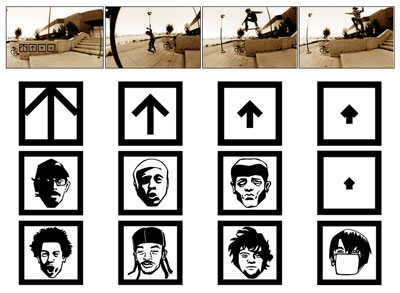
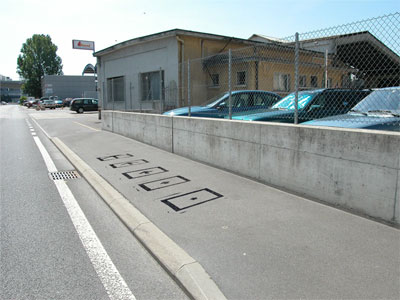
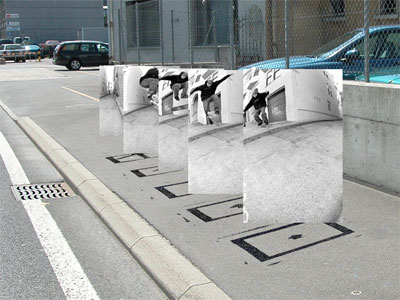
Why do I blog this? I like skateboarding and computing so I am curious when both merge.
Augmented street skating is a project done at ECAL by Valentin Kissling:


Why do I blog this? I like skateboarding and computing so I am curious when both merge.
Some design studio are envisionning the use of origami displays: as attested by this Origami Cell Phone and this Origami DVD player
This is a future cell phone concept developed at Inventables. The concept was inspired by the e-paper developed by Mag-Ink and the Popout Map. The map uses origami paper folding technique to expand and collapse automatically as it is opened and closed. This concept addresses the need for larger displays on cell phones without sacrificing a small form factor.The Origami DVD Player is a portable DVD player concept that could be manufactured with a new e-paper (a full-color flexible display technology) being developed by Mag-Ink in Israel. As a product, it would target the business traveler who wants a convenient way to watch DVD movies. For this user, portability is a key requirement, but they are not interested in sacrificing their viewing experience and are willing to invest extra money for a higher quality product.


Why do I blog this? this is an intriguing way of taking advantage of a small device to expand the display through e-paper...
Another origami-related tech: it may help cellphone cameras to focus. (via emily)
Heard in "No Maps for Those Territories" (doc interview of William Gibson):
"when those events occur, it changes the nature of the game; another example and maybe a better one is when it was confirmed that Michael Jackson was going to marry Elvis Presley's daughter, a good friend of mine in the States faxed me, and said 'this made your job more difficult' and I knew exactly what he meant"
What he means is if that is the world, what can he does to make the world more fantastic in his novels.
In 1912, Alphonse Norgeu did a wonderful postcard serie for the "Chocolat Lombart" company (printed on chromolithography); it's called "Comment vivront nos arrière-neveux en l'an 2012" (How will our grand-nephew live in 2012?)


(Source : Trésors des Postes et Télégraphes, PTT Cartophilie, 1989.)
1) Bonjour mon enfant... Nous t'envoyons ton Chocolat Lombart par l'aéronef des vides ! / Hello my son... We send you the Lombart Chocolate by the Indian Aeronef
2) Back from the Moon: in 8 hours, we'll have our Lombart Chocolate in Paris!
While doing random searches on google image, I ran across the work of Ingrid Hora. I like her research agenda:
There is a whole category of people living on the order of madness and normality. I want to narrate the life of a disordered (or hyper ordered) society, a life of people left on their own. People builds walls around themselves to create oder and borders. I am interested in showing what happens behind these walls, where obsessions, desires and fantasies hide. I want to show the anarchic constructions initiated by the individuals to accommodate their strange desires and needs.
For instance, see those two pictures:
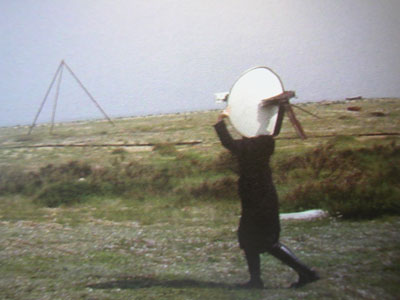
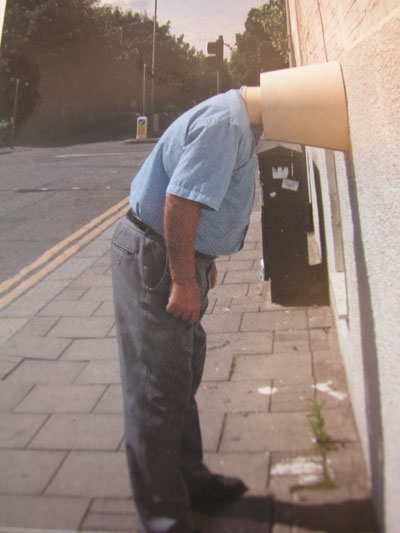
I basically found them on Regine's blog and I have nothing to contextualize (more than just the outline of her work described above) and I definitely makes me thing about how people modify ("détourne" in french) for other purposes that makes sense to them and not always for others.
Why do I blog this? this is a topic very interesting to me because of (1) cultural feeling, I tend to be interested in such borderlines experiences and how they are translated into behaviors/craft (2) how this affect technology usage research: what Ingrid Hora is nothing more than extreme users (or tinkerers) of technology.
Besides, see this rhetorical vision in her description: how "space" features (walls, borders...) are deployed? No space is not dead.
Deloitte's new report "Eye to the Future: How TMT advances could change the way we live in 2010" is a curious read; especially when it explains how technology is expected to keep changing the workplace and who will be able to manage it.
"More and more, the ability to get things done is expected to depend on the ability to understand and use increasingly complex technology - and those with a greater degree of technological literacy may find themselves moving up the corporate hierarchy more quickly than those without."
To me, there is also another step that they don't address: the "disconnection literacy": the fact that in a pervasive world with always-on capabilities, people will definitely need to disconnect. This, of course, to step away from information overload or passive physical behavior.
Will we have to pay to have a non-connected place? Will there be social differentiation about who will be aware of such a need?
Brainoff has posted this mapufacture, a geoRSS aggregator:
mapufacture is a GeoRSS aggregator. here you can layer multiple GeoRSS feeds from different sources into a single map, and search the database of GeoRSS feeds by keyword and location. search results are themselves available as GeoRSS feeds. if you do want to create a map, we ask that you go through a simple registration process.
Why do I blog this? this is the new trend, aggregating different flows of information on top of a spatial representation using the simple RSS adaptations. I like the idea of having search results as geoRSS feeds.
What I also find interesting is the fact that those RSS derived standards are more and more available and this should eventually lead to more interesting aggregating interfaces, what are the progress in this area so far? Lots of components could be helpful (spatial, social, datamining features...).
Chocolate Infinity is a project from the HMC MediaLab for Cadburys Chocolate Factory. It's carried out by Adam Montandon and HMC members. It interestingly used a shock sensitive floor and a series of motion sensors to immerse people in an intriguing interaction (to improve the visitors' experience):
As you enter the infinity room a giant chocolate bar melts into gloopy puddles beneath you and, when you jump in them, chocolate splashes all over the floor. Then a sprinkling of individual Roses chocolates appear beneath your feet. You won't believe your eyes when they unwrap as you tread on them – but as you step off they wrap back up.Chunks of chocolate then fill the floor and when you stamp on them they break open showing gooey caramel, squidgy turkish delight, chunks of mint, orange or Cadbury's Crunchie inside. Finally you get to chase three Creme Eggs across the floor but don't stand still because they'll pop their tops and taunt you until the game is on again.


Why do I blog this? this is one of the trends in roomware: using floor/sensor-based interactions to trigger specific behaviors. I see more and more project about that and I am wondering about potential new places that would allow people to play games with this settings (arcades revival?).
Cyber rodent seems to be a classical research project that use robots to study goal-directed behaviors.
Based on the theories of reinforcement learning and evolutionary computation, we exlore parallel learning mechanisms using a colony of small rodent-like mobile robots called Cyber Rodents. Cyber Rodent HardwareThe Cyber Rodent robot has an omnidirectional vision system as its eye, infra-red proximity sensors as its whiskers, two wheels for locomotion, and a three-color LED for emotional communication. Especially it has the capabilities of recharging from external battery packs and exchanging gene (program or data) via IR-ports.


Why do I blog this? just like the robot looking + the underlying idea of the project (learning mechanisms). Besides, it's interesting to see that the "rodent" metaphor is still in use even with robot counterparts...
 |
Mitsubishi Electric Research Lab (MERL), and Paul Dietz in particular, seems to be working on something called Submerging Technologies (as attested by this SIGGRAPH presentation): |
Goal: To show, somewhat whimsically, how emerging sensing technologies can be applied in unusual ways. Three interactive water displays: a tantalizing fountain that withdraws when a hand comes near, a musical harp with water "strings," and a liquid touchscreen.
Enhanced Life The displays apply emerging sensing technologies to the medium of water. In each case, the electro-optic properties of the water itself are exploited to make the water a fundamental element of the sensing system.
While there are serious industrial applications in coating, painting, and soldering for these sensing technologies, this project focuses on human interaction. The larger point is that as new sensing technologies become available, they can and will be used in very surprising ways to change how we interact with our world.
Why do I blog this? that's a curious context with challenging issues in terms of User Experience and human-artifacts interactions.
"Understanding and Designing for the Voluntary Adoption of Community Displays" by Harry Brignull is a very relevant thesis that deals with large digital wall display system for the support of informal social interaction in communal spaces.
One of the contributions of this thesis is a critical analysis of research studies revealing two distinct categories of Community Display settings: ‘one shot’ usage settings and ‘on-going’ usage settings. ‘One shot’ usage settings include one-off social events, conferences (McCarthy, 2003) and festivals (Agamanolis, 2003). (...) ‘On-going’ settings, on the other hand include common rooms (Houde et al, 1998), cafés (Churchill et al, 2003), and relaxation areas (Grasso, 2003), and are used regularly by an established community over a period of months or years.Findings show that that the spatial distribution of interaction around a Community Display is of crucial importance to understanding its usage and adoption. The concept of ‘flow’ is introduced to describe the manner in which users move through space; and the concept of a ‘honey pot’ is introduced to describe the public interaction space around a community display which users are attracted to and congregate in because of the resources it offers. The public availability of interaction with a Community Display is found to be important in that it allows others to ‘oversee’ interaction while going about other things (Heath and Luff, 1991), creating opportunities for them to join in, and thus facilitating spontaneous social congregations. This overseeing is also found to be crucial to the learning process - studies carried out show that people predominantly learned about Community Displays by observing others using them, i.e. vicariously.
Why do I blog this? I am interested in how interaction could be spatially distributed and how potential users could apprehend such artefacts because it relates with my research about the impacts of technologies on space and place.
Cyril has an interesting post about the "death of video-games". IMO video games creativity is not dead. What is dead is the video game development model which suck and is so publisher-driven that it kills innovation. Garage studios are no longer viable, in-house studios are following the headquarters order and cut innovation; and even when it comes to outsourcing, there is nothing good out of it. Of course there are still some good and innovative studios (blizzard) but they're less and less. I think Water Cooler also addresses that issue. To me, what is interesting is that the most important innovation with regards to video games are
And this is interesting because video/computer games are now starting not only a tiny platforms but they're is now an ecology of artifacts connected to them which eventually are targeted at engaging people in playful activities such as developing DYI games, creating or watching machinimas, playing games with tangible interactions...
Why do I blog this? I am interested in foresight issues related to this sort of activities and how games is evolving from a very precise activity to a culture with fuzzier boundaries.
(Via), this Neverending Drawing project (by Oskar Karlin) is very neat:
Never ending drawing is a project I started in Stockholm five years ago. Inspired by Douglas Coupland’s book Microserfs, Paul Auster’s New York Trilogy and some drawings made by my sister I started mapping my movements in the city. I downloaded a map over Stockholm and pasted it into Illustrator and drew my movents in separate layers each day. After two years I moved to Berlin and then London and continued the project there. Earlier this year during a trip I also mapped my movements in Los Angeles, San Francisco and New York.My limitations are a defined area around the central parts of the city I am in. So if I go outside the “borders” I don’t map it out. You could call it vacation. Since all the data is stored in vector format it is easy to work with.
An example: on the left is is Stockholm, Berlin and London on top of each other, and on the right, it's basically the same as but instead of outlinesKarlin have filled each day with a color with low transparency(Stockholm is green, Berlin is red and London is blue).


Why do I blog this? I like this sort of visualization/city mapping; the chaos created is intriguing and quite situationist. Overlaps are pertinent, maybe this is an instantiation of the Global City.
Time has an article about Nintendo's strategy. There is a relevant point there:
Nintendo can reinvent gaming and in the process turn nongamers into gamers. (...) "Why do people who don't play video games not play them?" Iwata has been asking himself, and his employees, that question for the past five years. And what Iwata has noticed is something that most gamers have long ago forgotten: to nongamers, video games are really hard (...) The learning curve is steep.That presents a problem of what engineers call interface design: How do you make it easier for players to tell the machine what they want it to do? "During the past five years, we were always telling them we have to do something new, something very different," Miyamoto says (like Iwata, he speaks through an interpreter). "And the game interface has to be the key. Without changing the interface we could not attract nongamers." So they changed it. (...) Of course, hardware is only half the picture. The other half is the games themselves. "We created a task force internally at Nintendo," Iwata says, "whose objective was to come up with games that would attract people who don't play games."
And this seems to attract game designers:
John Schappert, a senior vice president at Electronic Arts, is overseeing a version of the venerable Madden football series for Nintendo's new hardware. He sees the controller from the auteur's perspective, as an opportunity but also a huge challenge. "Our engineers now have to decipher what the user is doing," he says. "'Is that a throw gesture? Is it a juke? A stiff arm?' Everyone knows how to make a throwing motion, but we all have our own unique way of throwing." But consider the upside: you're basically playing football in your living room.
"No buttons to press, just gesture": the essence of tangible interactions!
In addition, in terms of innovation, the article highlights few important concerns:
Nintendo has grasped two important notions that have eluded its competitors. The first is, Don't listen to your customers. The hard-core gaming community is extremely vocal--they blog a lot--but if Nintendo kept listening to them, hard-core gamers would be the only audience it ever had. (...) Cutting-edge design has become more important than cutting-edge technology. There is a persistent belief among engineers that consumers want more power and more features. That is incorrect. (...) intendo is the Apple of the gaming world, and it's betting its future on the same wisdom. The race is not to him who hulas fastest, it's to him who looks hottest doing it.
Why do I blog this? My interest for this console (and hence this article) is threefold: (1) I am curious to try it out (2) it's a good step towards the use of tangible computing metaphors (3) the innovation model of Nintendo is interesting.
BlueWay is a project carried out at the ITP by Myra Einstein, David Yates, Robert Faludi, Arly Caryn Ross, Leif Mangelsen:
BlueWay at the Spring Show provides personalized guidance to friends, business contacts, locations, projects, and services by taking advantage of technology already carried by most users.Visitors at a BlueWay kiosk can have have their picture taken and linked to their Bluetooth-enabled device. As they move through the space, BlueWay senses the visitor’s presence using their Bluetooth ID and displays their location. Participants receive pertinent wayfinding information when and where they need it. Their presence is depicted on master display maps, so other people can also quickly find them. These signs even benefit guests who do not register with the system, because the useful information they provide is visible to everyone.

Why do I blog this? yet another location-based application using bluetooth that aims at providing guidance/wayfinding information. IMO what is more interesting here is to use the bluetooth ID as presence/community indicator.
News.com has a great account of the Metaverse Summit, which was about how video game design, geospatial engineering, high-tech research, software development, social networking, telecommunications would reshape the virtual world (or the overlap between the physical and the real world). The outcome they highlight is that "agreement about the metaverse of 2016 was hard to find", which is of course interesting to me. Here are some trends they discuss:
"I thought we were going to focus a bit more on virtual worlds because when I hear the term metaverse, I hear 3D virtual worlds. And we ended up talking about virtual worlds as well as augmented reality, which to me is kind of separate technology in its vision," Moore said [PARC] (...) One of the questions asked most frequently throughout the event was whether an overriding metaverse of 2016 will be commercially owned or open source. There was little agreement about that, but it was clear that the companies seen as most likely to provide the tools for a single metaverse upon which many 3D, social applications could be built are Microsoft and Google.
In part, Google was seen as more likely because of its development of Google Earth and its recent purchase of the maker of the 3D modeling software, Sketchup. (...) In addition, there was a general consensus that--as mobile devices become more sophisticated--the 3D Web would become much more the province of such devices and far less of the kinds of desktop or laptop computers we know today.
A public document that would wrap up this will be published by the end of the summer. Why do I blog this? I am interested (from my research perspective) about how technology reshape spatial practices.
Today I had a meeting with my PhD advisor about the thesis outline - which is actually more than that since we discussed the research rationale (le fil rouge of the dissertation) as well as the expected contribution. As Chris Johnson puts it, the work should be articulated around three dimensions: a contribution to a field of research (in my case the effects of location awareness on collaboration which is an investigation of the behavioral issues related to this technology), a proper grounding in experimental techniques (the description of the field experiments I conducted and my concern about taking advantage of both qualitative and quantitative data; even though it's quantitative dominant) and finally a contribution to the design and implementation of interactive systems (which would be made through guidelines, recommendation and why not a method to analyze mobile collaboration).
The diss will hence address all of these issues with regards to location-awareness and collaborative processes such as group performance, comunication, mutual modeling, negotiation of a group strategy. For that matter, I will present the results from Spaceminers (virtual world on the left below) and those from CatchBob! (pervasive game, on the right below). This would eventually lead me to a discussion of the benefits and drawbacks of location-awareness in both a virtual world and a pervasive environment.


Regine pointed me on this cool event: a opera for nabaztag at the Web Flash Festival on May 27th. It's a kind of flash mob with communicating artifacts: 100 Nabzatags (Wifi rabbits) brought by their owners will play an opera created by Antoine Schmitt et Jean-Jacques Birgé at the Centre Pompidou in Paris.
 Why do I blog this? a flash mob of objects is surely a 2006 technosocial situation.
Why do I blog this? a flash mob of objects is surely a 2006 technosocial situation.
cph127 has a good point about what they call "the rise of beta": the very fact that . everything is launched as beta and everything happens to be unfinished. They wrote a beta-manifesto, here are some excerpts:
- being in beta is a natural state of life. Everything aroundus is either evolving or dying.
- beta is playing. Experimenting. Trying.
- beta is constant learning.
- beta is profiting in the true nature of the word “profit”. Making progress.
- beta is never perfect. Never completely without fault. Just like any human being. Everything can be made better. Allways. Achieving temporary perfection is better than aspiring for the ultimate perfection that is never reached.
- beta is release as soon as it is safe. But never sooner. Only daredevils flies planes in beta or takes unfinished medicine.
- beta is a natural state of things. Your body is in perpetual beta until you die (maybe..)
- beta is evolution. Many small gradual changes. Suddenly they may seem like giant leaps.
- beta is revolution. Not completely in control. Just like the real world.
- beta is open. Ready for dialogue. Open for change. Positive for co-creation.
- beta stands for things that changes. Change with consistancy.
- beta creates feedback loops for companies, individuals and products.
- beta is honest. Not superficial.
Why do I blog this? First I think the "beta" phenomenon is interesting as a shift in our society from all-set product to constantly evolving "stuff"; the assumptions behind this are both important (product can be improve and are opened) and intriguing (everything needs to change change change...). Second, what will be curious IMO is whether this beta mindset will also reach the pervasive computing world: we would then have unfinished objects and services. After the blue-screen of death for your bathroom, there would then be uncompleted features that you might not be able to use with a "beta-meter" close to the flusher...
Researchers in LA are trying to help world's biggest media companies and their high-profile clients understanding the divided consumer's attention span (source: NYT):
The Emerging Media Lab is run by Interpublic, a holding company for media- buying firms like Universal McCann and Initiative. Since February, clients like Sony, L'Oréal and Microsoft have been using the lab to try to figure out how to reach consumers who seem to be doing so many things simultaneously. (...) Market researchers as a whole are struggling to understand the realities of what often is called "concurrent media usage." (...) For advertisers, the challenge is getting the message across in one medium while the consumer is simultaneously active in several media. (...) In the Emerging Media Lab, advertisers can observe "engagement." Using cameras that feed back into an observation room, advertisers watch consumers use old technologies or try new ones.But it does seem that a consumer who is multitasking is not devoting an equal amount of interest to all those activities. "Terms like multitasking imply equal attention," said Mike Bloxham, director of testing and assessment at Ball State University in Muncie, Indiana. "But cognitive science tells us this isn't possible. You have to give priority to one in order to absorb the messages."
Research or market research? It's clear that they are facing a real challenge but I tend to be quite pessimistic towards the advertisement world, which is actually not so much of a problem to me...